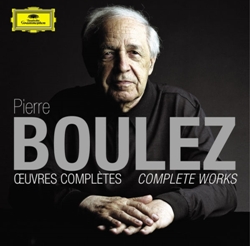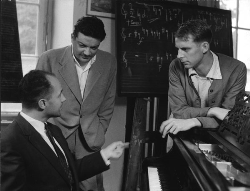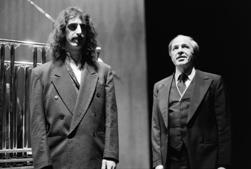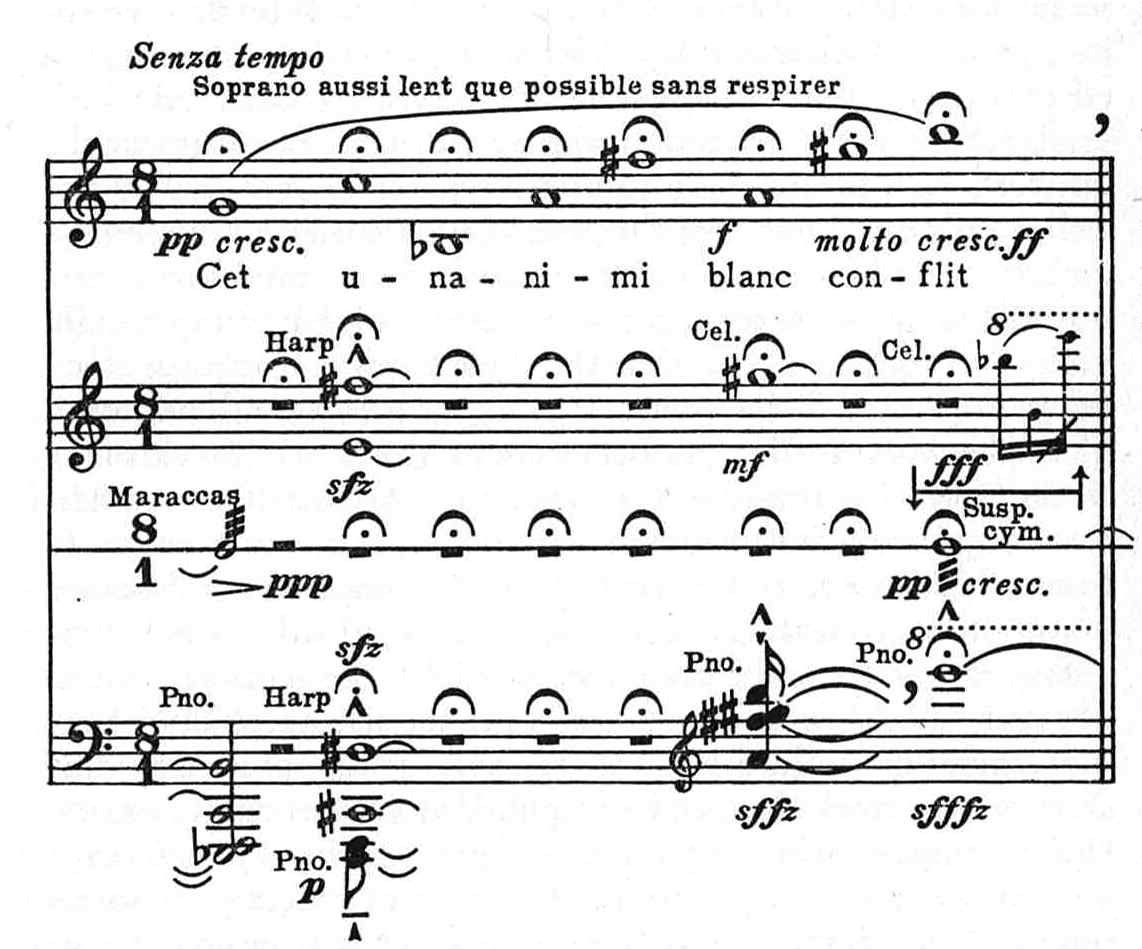
Pierre Boulez: Complete Works
Various artists
Deutsche Grammophon
13 CDs, released 2013
Buy at Amazon.com
Le Soleil des Eaux is an early cantata based on two René Char poems. It was written in 1948 and subsequently revised many times, culminating in the fourth version from 1965. This collection offers both the final version and an intermediary second version from 1950. Stylistically the work owes much to Schoenberg's Ewartung, spinning its content out of brief motives, and emphasizing orchestral and vocal color and sharp, angular melodic lines. The first movement is a dialog between the solo soprano, usually unaccompanied, and the orchestra, which tends to enter (seemingly impatiently) on the last word of the soprano's phrases, an effect that reminds me of the woodwind "Fighting Answerers" that respond to the trumpet in Ives' The Unanswered Question. The chorus is suppressed until the second movement, which opens with a bit of atmospheric scoring reminiscent of Debussy. This passage was solely instrumental in the 1950 version, but in 1965 Boulez added wordless female choristers. In both cases he seems to be evoking the memory of a misty riverside. And indeed the first word in the text is rivière, but when we hear it, it's shouted out by the male choristers in a surprisingly menacing fashion. Throughout the movement a wide variety of vocal approaches is used, from the aforementioned textless singing and shouting to speaking, heightened speech, whispering, and dividing the voices into two parts: one singing the text while the other hums an accompanying line. Boulez, of course, also exploits the contrast between the solo soprano and the choral voices. Though the first movement is dialectic in design, in the second movement voices and instruments are heard simultaneously (even if they're usually doing separate things). The 1965 version lacks the rather breathtaking ending of the earlier versions, where after the word l'horizon is spoken, the orchestra descends gradually from a high E7 in the violins and glockenspiel to a soft harp bisbigliando on low D2. Only the latter note is retained in the final version.
Le Visage Nuptial is another early René Char cantata that underwent subsequent revisions. The first version from 1946 (for voice and four instruments) and the second version from 1952 (for soprano, contralto, female chorus and orchestra) were both remarkable for incorporating quarter-tone intonation into a serial structure. Boulez in fact devised full 24-tone rows for the occasion. But the difficulty in performing such music led Boulez to create a third version during the late 1980s that retains the second version's instrumentation and five-movement form but eliminates its quarter-tones in favor of conventional 12-tone tuning. Unfortunately the Complete Works set only includes this watered-down final version. Its 1989 performance featuring the BBC Singers and the BBC Symphony Orchestra under Boulez is admirable. But it would have been very nice to hear the second version done by modern musicians, as it represents a unique bridge between two important 20th century developments: microtonal music and serial music. Neither microtonal version is available in recorded form as I write this.
Nevertheless even the final version of Le Visage Nuptial demonstrates another Boulez innovation, one picked up and eagerly carried forward by subsequent "sound surface" composers like Ligeti, Penderecki and Xenakis: the use of independently notated lines for each string player. Several passages feature this kind of writing, including several prominent ones in the fifth movement. It's an orchestration technique previously used only for wind instruments. The result isn't that you really hear, say, 30 solo violin lines (there isn't that much acoustic differentiation), but rather a kind of heterostatic texture, something that Cardew called "an organic vitality within the mass of sound" that Boulez couldn't have achieved with conventional string writing nor by granting the players semi-improvisational leeway.
Other highlights from Le Visage Nuptial include the obsessive clanging of crotales in the second movement and the emphasis on trills and up-tempo
passages in the third movement (which depicts the "Visage nuptial" itself).
The text to the fourth movement, Evadné, was spoken by the female chorus in
the second version, but in this final version they sing it on a static
pitch. You can hear how Stravinsky was influenced by this music in his last
masterpiece, the Requiem Canticles.

Boulez, Maderna, Stockhausen
Le Marteau sans Maître is the quintessential post-Webern piece. It remains Boulez's most famous composition, and it seems to have secured a permanent place in music history textbooks as the epitome of Darmstadt School serialism. It's offered here in two performances: one historical (the 1964 Paris recording with Jeanne Deroubaix as the vocalist) and one modern (2002 with Hilary Summers and Ensemble intercontemporain). Comparing the two, I'm struck not only by the skill of the 2002 musicians, but also by how good the 1964 performance sounds given the standards of a half-century ago. All these musicians manage to gracefully navigate the rapid, jagged lines and sudden starts and stops which aptly complement René Char's texts, themselves successions of oddly juxtaposed discontinuities. By the way, the Columbia recording from the 1960s with Yvonne Minton is not included in this DG-centric collection.
Most of Boulez's music from the 1940s and 1950s is pointillist in rhythm, with occasional exceptions like the second movement of Marteau (which has a steady pulse in the percussion). In the 1970s, though, regular beats appear more frequently in his music, and rapidly repeated notes became a notable stylistic trait. A couple of lesser-known pieces provide good examples of this. Messagesquisse (a unique piece in many respects, written for Rostropovich and scored for one solo cello with a bunch of ensemble cellos), and Sur Incises (for three pianos, three harps and three percussionists). The latter's conjunction of unusual instrumentation and emphasis on repeated notes (in the first of its two "Moments") makes it sound a bit like post-serial Steve Reich. Hearing this work I'm reminded of Steve Schwartz's take on Boulez, which "differs from that of many others, who picture him as a super-brain, to the exclusion of everything else." Schwartz sees him instead "in the long line of French composers besotted with color and the sensuous form". Repeated notes are also emphasized in the brief, late piano piece Une page d'éphéméride ("a page of ephemerals") written for student pianists, and sounding utterly unlike Structures or the Piano Sonatas. It's as close as Boulez ever came to the sound world of late Scriabin.
Boulez's experience as a conductor certainly manifested itself in a masterful use of instrumental technique and timbre. Indeed my favorite Boulez works are the ensemble pieces with the widest range of color, works like Rituel, Pli selon Pli, the concerto version of Domains, and Éclat/Multiples. Rituel appears in its première 1976 recording, with the BBC Symphony (conducted by Boulez of course). It was written in memory of Bruno Maderna, an important conductor of new music, and an underrated and eclectic composer. Despite the dedication, the music sounds more like Messiaen than either Maderna or stereotypical Boulez. Basically it's a series of homophonic funeral processions in steady meter (!) played simultaneously by eight different (and physically separated) instrumental groups whose individual tempi are coordinated by a central conductor. There's even a "main theme", stated at the outset by a solo oboe in an easily recognized rhythm characterized by a grace note pickup to a sustained tone. Perhaps because it's metered, and because its form is easy to follow, Rituel has become one of Boulez's most popular works, and it's certainly one of his most unusual and beautiful creations.
Répons was a turning point for Boulez: his first major composition completed after the founding of IRCAM, and his first major foray into combining live instruments with digital sound. During its première tour in the mid-1980s, it aroused both admiration and envy from other composers (the money spent on Répons alone could have funded productions of many underexposed 20th century compositions). The skepticism seemed strongest in North America, where musicians had been working with both live electronics and computers for decades with far less institutional support (and some would say, far less pretense). It didn't help that the piece was presented as a showcase for the ego of the composer/conductor himself, his geographically central face being the only prominent one among the dozens of spread out musicians and technicians. Boulez himself likened it to a Bunraku troupe where only the master puppeteer is unmasked. I recall a documentary video in which Boulez is shown trying out a few pages of drafts with several musicians, then writing down some musical ideas while the others wait. One is struck both at the resources he had available and by his ability to compose with dozens of people, including a camera crew, staring at him.
...explosante-fixe... is presented both in its brief original version (as a memorial to Stravinsky), and in its eventual epic 36-minute long version as a concerto for MIDI flute and chamber orchestra (including two MIDI-controlled "shadow" flutes with elaborate sound projection instructions included in the score). I think it's the most successful of Boulez's live electronic pieces, and as a fully notated composition for both acoustic and digital electronic instruments it anticipates several works by Tod Machover and others that inhabit the "institutional" stream associated with the likes of IRCAM and MIT (whereas the more thematic stream of live electronic music has long been owned by more independent and improvisionally-oriented musicians influenced by jazz and John Cage). You really need to hear ...explosante-fixe... in a live performance to understand how space is used as a parameter, but this recording is about as good as it gets in a stereophonic context.
Then there's Pli selon Pli, an hour-long cantata on Mallarmé poems for soprano and orchestra. The magnum opus of Boulez's pre-IRCAM years, it may well be his greatest work. Its "definitive 1989 version" is presented here in a world-class 2001 performance featuring Boulez, Ensemble Intercontemporain and the great Christine Schäfer. There's nothing quite like experiencing the energy imparted by hearing this rhythmically challenging music performed by musicians who have mastered the material and can traverse its darting atonal lines perfectly in sync. Boulez's 1969 recording of the first complete version is accomplished, but its personnel can't compete with these musicians, virtuosi able to build on 30 years of ensuing improvements in overall standards for performing postmodern music.
The makeup and proportions of Pli selon Pli’s orchestra are unique, and the instrumentation is different in each of the five movements (since they’re all designed to work as standalone pieces). Bowed strings are diminished to soli levels (about 20 in all), piano and celesta are included, and woodwinds are reapportioned (four flutes, four clarinets and two saxophones, but only one bassoon and no oboes). The brass section is typically sized, but the percussion section requires about half a dozen musicians and takes up about half the total stage footprint including a generous complement of mallet instruments (in the interview on CD 13, Boulez expresses his disdain for unpitched percussion in general, considering rhythm and timbre alone to be insufficiently communicative compared to pitched instruments, thus explaining the lack of any surviving Boulez compositions for percussion alone). In a nod to Schoenberg's Op. 24, Boulez adds a mandolin and guitar (requiring subtle amplification), and three harpists of which more will be said below.
The first of Pli selon Pli's movements is entitled Don, from Mallarmé "Don du poème", where don means talent or flair, something "given" (donné). It opens with a loud, sharp tutti chord trailed by softer sustained string tones (harmonics on top, normale on the bottom). It's a characteristic Boulez effect, also much used in the Third Piano Sonata's Constellation-Miroir movement. The chord itself is an interesting thing: all twelve pitch classes are present, with the highest C♮ the only doubled note. The major third relationship between that C♮ and the bottom E♮ adds a hint of C major tonality to the sonority, reinforced by including those notes in the subset of outer pitches that are sustained after the initial attack:
The soprano sings the poem's first lines, then drops out for several minutes while the orchestra takes over. She re-enters about 2/3 of the way through, alternating singing and whispering to the wistful accompaniment of muted string trills and maracas. Throughout the movement, the accomplished French tradition of orchestration is evident: a relentless stream of attractive colors displaying the influence of Berlioz, Debussy, Ravel and Messiaen.
After Don comes three Improvisations on Mallarmé, each setting a different sonnet. The first Improvisation uses the poet's "Le vierge, le vivace et le bel aujourd'hui". Its vocal and instrumental lines emphasize dissonant intervals (both in a harmonic and melodic sense), and the voice part's rhythms are often built around grace notes, giving it a skipping quality quite characteristic of Boulez (c.f. Rituel).
The alto saxophones, used only in this one movement, add a bit of seasoning. And a nice touch is the soft passage for multiple drums, featuring ruffs, that concludes the movement. Here we see a very explicit instance of Varèse's influence on Boulez, an influence that's felt throughout Boulez's oeuvre in his emphasis on dissonant intervals and in the rhythmically independent writing for percussion. (As an aside, among the 20th century's great composers, it's Varèse who importance seems to have been most consistently underacknowledged in print. His influence is arguably as great as Schoenberg's or Stravinsky's, given that he was a pioneer both of modernist atonality and of postmodernist electronic music. But few writers other than Joan Peyser have placed him on a level commiserate with those two giants).
The second Improvisation (on the poem "Une dentelle s'abolit") has more silence in it, and strips the instrumentation down to a chamber ensemble that backs the soprano. Interestingly, it's the traditional orchestral instruments (bowed strings and winds) that are suppressed in favor of keyboards, harps and percussion. Note the evocative melismatic setting of the opening line ("A lace vanishes"). A characteristic moment comes at the 2:28 mark in this recording, where there's an 8/1 measure in which the soprano sings the text "Cet unanimi blanc conflit" on eight even whole notes (the sonnet is in octameter, and this line, in contrast to the opening, is set syllabically). Other musicians have to follow her tempo and insert their notes at the appropriate time. In the score used in the 1969 recording the singer was supposed to proceed as slowly as possible without breathing, but in the final version, sopranos (including Schäfer here) are allowed to take a breath before "blanc".
The third Improvisation ("A la nue accablante tu") uses particularly outlandish scoring, with three harps (two tuned in quarter-tones), mandolin, guitar and multiple mallet instruments including almglocken and two five-octave xylorimbas played by four musicians. The more conventional instruments are limited to cellos, basses, one trombone and four flutes/piccolos (another influence on Stravinsky's Requiem Canticles perhaps, specifically its Interlude?). The abundance of plucked and percussion instruments creates a Partch-like timbral world — imagine The Bewitched, but atonal and non-metered! Matthias Pintscher finds "the most excessive writing for tubular bells that had ever been heard" in this movement, and the vocal line includes some crazy melismas in the high register. The middle section of the third Improvisation is for instruments alone, and emphasizes short, sharp notes in the plucked and percussion instruments accompanied by sustained notes in the winds and bowed strings, often with a crescendo over the duration of an individual note. In total, this Improvisation is a 16-minute virtuoso workout for everyone involved, and it's thrilling in the hands of top notch musicians! It's this movement that received the most substantial makeover in the 1989 version, winding up about 1/3 longer than before. And although the revision adds more passages emphasizing the multiple flutes with soprano (as at 3:00 for example), it also features fewer passages foregrounding the plucked and percussion instruments (though the remaining ones starting at 6:00 and 9:00 are pretty characteristic).
The final movement is called Tombeau, and sets only the last line of the eponymous poem. Again there's an extended voiceless middle section — it's the grand climax of the work, a kind of full orchestra treatment of Marteau-style pointillism. Most musicians that attempt to cope with its complex rhythmic notation and atonal leaps wind up conveying a significant degree of strain, but these musicians instead convey an incredible sense of excitement and joie de vivre. After the instrumental climax, the soprano returns, her text ending with the word "mort" after which the work ends like it began, with a loud, sharp chord.
Like Ives' 4th Symphony, Pli selon Pli is a work that doesn't explicitly theatricalize itself or parameterize physical space, but nevertheless benefits greatly from being seen in performance. The visual reinforcement of what the musicians are doing alone helps clarify the structure and the moment-to-moment unfolding of such a complex ensemble piece. As I write this, Arte TV has published online video from a 2015 Paris performance by Pintscher, Marisol Montalvo and Ensemble Intercontemporain. It's highly recommended for anyone not lucky enough to have actually seen this piece performed in the flesh.
As noted by many, this set isn't a true complete edition, but has been
carefully curated by the notoriously perfectionistic Boulez. He explains his
rationale, specifically his reasons for omitting a few works, in the course
of a long interview that makes up the 13th CD (Boulez also speaks fluent
English and German, but you'll need to look elsewhere to hear him in those
languages—at least the accompanying booklet, if you purchase the set on
discs rather than downloading it, includes an English transcription). Aside
from juvenilia, there are two particular omissions of note: Poésie pour
Pouvoir, a piece for tape and orchestra from 1958, and Polyphonie X, a piece
for 18 instruments from 1951 that used quarter-tones in a serial context
like the first version of Le Visage Nuptual. Both works were quickly
withdrawn, but are still available in a Boulez: Orchestral & Chamber Works
CD from Col Legno which captures their world premières (accompanied by much
audience derision in the case of Polyphonie X). Grab that CD, or the
40 Year Donaueschinger retrospective set (which has the same recordings) while you
can to fill out the most important "missing" works from this collection.

Boulez with unidentified American iconoclast
Boulez is traditionally linked to the Darmstadt School, that post-WW2 generation of European composers who were heavily influenced by Webern, and began their careers writing serial, pointillist music. This style started with the proposition that a single note could be a world onto itself, while two notes could make a counterpoint. The reverence was to the simplest aspects (or parameters, to use the technical term) of the musical materials, and ideas for larger compositions grew out of that fundamental premise. Stockhausen, Berio, Nono, Maderna and others were associated with this school as well, but whereas those composers eventually departed from serialism into pastiche, theater, tape music or an interest in language or politics, Boulez stayed true to a Webernian stylistic trajectory throughout his career. In this respect there's a commonality with American academic composers like Babbitt, Wuorinen and Martino, but Boulez's music always seemed to sound much better for the chosen instruments. He also had the good sense, when writing vocal music, to use only abstract, surrealist texts. This ameliorates the problem of text unintelligibility, and inoculates the music from being quickly obsolesced by extramusical factors like politics (Nono) or vernacular collage that now sounds dated (Berio). Boulez also bucked the trend of many composers to branch out into stage works and intermedia, staying focused on musical thinking. Despite this single-mindedness, his influence ran far and wide as one of the two most successful post-Webernian composers (Feldman being the other). And he added to that influence through his accomplishments as a conductor and spokesman for 20th century music. Even Frank Zappa can be counted among his acolytes, writing numerous orchestral pieces that sound like Boulez with a rhythm section.
As a young man, I respected Boulez and enjoyed most of his music, but I didn't love it the way I loved Cage and Stockhausen. Nor would I necessarily go out of my way to see a Boulez work performed, whereas I might go to great lengths to experience a Berio theater piece. Today, with some decades elapsed, and with this cherishingly-produced retrospective edition at hand, I've had the pleasure of rediscovering and reassessing his legacy anew. And although I would still say his music is less imaginative than the far-out contributions of the three composers named just above, I ponder, as you might, whether the craft, colorful instrumentation, precise notation and coherent stylistic evolution of Boulez's music might ultimately make it the most enduring of the lot.
- First published May 2015
Tweet![]()
Selected writings |
Schellsburg home
Jerry Hunt |
cribbage
![]()
Original Material and HTML Coding Copyright © 2015–20 by
Michael Schell. All Rights Reserved.



